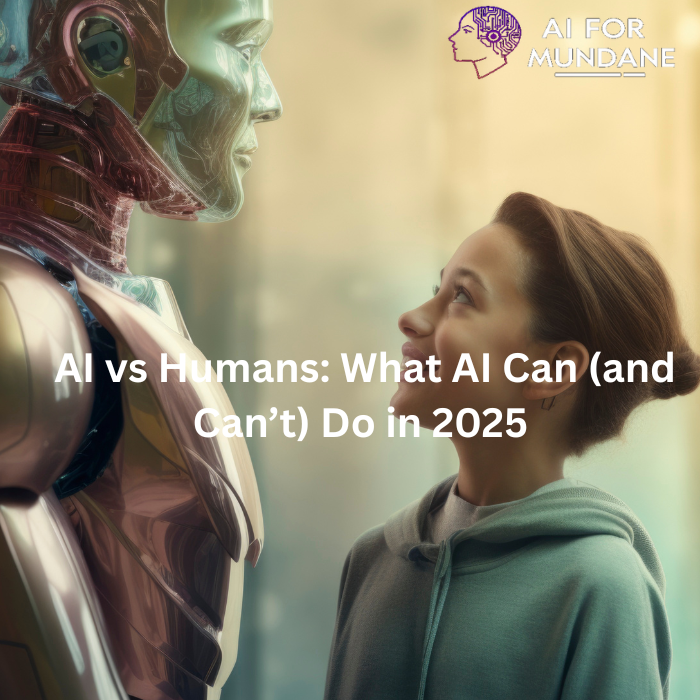AI vs Humans: What AI Can (and Can’t) Do in 2025
Artificial Intelligence is reshaping how we live and work. It writes emails, creates designs, powers search engines, assists doctors, and even drives cars. But for all its speed and efficiency, AI still has real limitations—and there are many areas where humans remain essential.
So what can AI actually do better than us in 2025? And where do humans still have the upper hand?
What AI Can Do Better Than Humans
1. Process Massive Amounts of Information
AI can analyze millions of data points in seconds, far beyond what any human mind can absorb.
Example: ChatGPT can summarize a 20-page report or analyze thousands of customer reviews instantly.
2. Automate Repetitive, Rule-Based Tasks
Tasks that are repetitive and follow clear instructions are perfect for AI.
Example: AI is used in accounting software to categorize invoices and in marketing to schedule and optimize email campaigns.
3. Generate Content at Scale
AI tools can write blogs, captions, emails, and more in minutes.
Example: Jasper or Copy.ai can produce ad copy or product descriptions in seconds, saving hours of manual writing.
4. Translate Languages in Real-Time
AI can translate multiple languages with surprising accuracy, making global communication more seamless.
Example: Google Translate and DeepL are widely used for instant translation of text, speech, or even entire documents.
5. Spot Patterns in Complex Data
AI can detect patterns that humans often miss, helping in fraud detection, recommendation systems, and health predictions.
Example: Streaming platforms like Spotify or Netflix use AI to suggest content based on listening and viewing patterns.
Where Humans Still Lead
1. Emotional Intelligence and Context
AI can mimic conversation but doesn’t truly understand emotions, tone, or sarcasm.
Example: AI chatbots often misinterpret emotional cues, especially in sensitive or nuanced conversations.
2. Original Creativity and Innovation
AI can remix existing content but lacks true imagination or the ability to create from nothing.
Example: AI can imitate painting styles, but it can’t invent a new artistic movement or philosophy.
3. Moral and Ethical Judgement
AI doesn’t have values, empathy, or a conscience.
Example: Making decisions about who should receive a life-saving resource is still a deeply human responsibility.
4. Building Genuine Human Relationships
Trust, empathy, mentorship, and emotional support cannot be programmed.
Example: An AI assistant can help schedule meetings, but it can’t offer life advice or emotional connection like a friend or mentor.
5. Adapting to Unexpected Situations
AI struggles with unpredictability. Humans can improvise and make decisions in real-time under pressure.
Example: A human can reroute during a natural disaster or handle a surprise technical issue better than most AI systems.
Will AI Replace Humans?
No. At least not in the ways that matter most. AI is a powerful tool, but it lacks human values, emotional depth, and true decision-making ability.
The real future isn’t AI vs. humans. It’s AI working with humans.
AI handles the repetitive, data-heavy, time-consuming work.
Humans lead with creativity, emotion, and ethical understanding.
Together, this creates a smarter and more balanced way to solve problems.
Quick Comparison
| AI Excels At | Humans Are Better At |
|---|---|
| Repetitive and rule-based tasks | Understanding emotions and context |
| Processing and analyzing data | Making ethical and moral decisions |
| Translating languages | Thinking creatively and originally |
| Generating structured content | Building meaningful relationships |
| Recognizing patterns | Adapting in unpredictable situations |
Final Thoughts
In 2025, AI continues to evolve—and it’s here to stay. It’s fast, capable, and useful. But it’s not human. It doesn’t think, feel, or create the way we do.
The smartest thing we can do is learn to work with AI, not against it. Use it to extend your abilities, not replace them.
Stay human. Stay curious. And stay in control.
Follow AI For Mundane for beginner-friendly insights, AI guides, and practical tools that help you navigate the world of everyday artificial intelligence.






